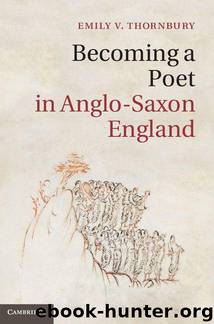Becoming a Poet in Anglo-Saxon England (Cambridge Studies in Medieval Literature) by Thornbury Emily V

Author:Thornbury, Emily V. [Thornbury, Emily V.]
Language: eng
Format: azw3
Publisher: Cambridge University Press
Published: 2014-01-30T16:00:00+00:00
Home renovations: Christ and Satan
‘Liber II’ in Junius XI seems something of an afterthought. The first 212 pages, containing Genesis, Exodus, and Daniel, were written by one scribe in a well-spaced vernacular book-hand, with blank half-sheets and pages left for a partially completed programme of illustration.1 The final eighteen pages (of which the last one and a half are blank) were shoehorned into a single gathering beginning on page 211, with the aid of two added single sheets and a bifolium.2 Two or three scribes filled most of this last gathering sometime in the early eleventh century.3 The incompetence of the first of these scribes evidently irked a more or less contemporary reader, who made a number of additions and alterations to pages 213–15 particularly, though this corrector was also interested in making the poem conform generally to late West Saxon linguistic standards.4
Christ and Satan, however, does not conform well to any standards. Its style is repetitive, with many flaws in the metre – of which some but not all can be attributed to the text’s poor state of transmission. As a poem on mainly apocryphal New Testament subjects, it seems ill-suited to the main Junius XI collection. As a narrative, its sequence is disrupted to no clear artistic purpose, particularly in its relation of Christ’s temptation in the wilderness after the Harrowing of Hell. Critics have several times tried to justify the planned unity of Christ and Satan individually, and as part of a sequence in Junius XI; but their proposed thematic frameworks tend to be so broad as to encompass almost any Christian text.5
The question of unity has been taken up so often because doubt on this point is so easy to justify. The three main topics of Christ and Satan are very loosely connected thematically, chronologically, and within the text. In 1877, Ten Brink simply declared that there were three different poems, which he called ‘Die gefallenen Engel’ (lines 1–365), ‘Christi Höllenfahrt und Auferstehung’ (lines 366–664), and ‘Christi Versuchung’ (lines 665–733, using a slightly different lineation than the ASPR).6 A few scholars adopted this division, but in the twentieth and twenty-first centuries most have been inclined to treat Christ and Satan as a single work, even if they harboured doubts.7 The evidence of the manuscript tends to justify the ‘unificationists’. Though the poem is divided into twelve (perhaps thirteen) fitts of varying lengths, the capital that begins Fitt 8 (at line 366, the beginning of Ten Brink’s second division) does not differ from other fitt initials, and is certainly smaller than the poem’s first initial on p. 213. The most elaborate initial in Liber II (a little zoomorphic h on p. 226, formed by a winged catlike creature intertwined with a bird of prey) begins Fitt 12 at line 597, and thus falls within Ten Brink’s second poem. The fitt numbers are sequential and begin with the poem, though only numbers II, III, V, and VI were added to the manuscript.8 It seems most likely, therefore, that Christ and Satan was intended to be read as a unit.
Download
This site does not store any files on its server. We only index and link to content provided by other sites. Please contact the content providers to delete copyright contents if any and email us, we'll remove relevant links or contents immediately.
| Ancient & Classical | Arthurian Romance |
| Beat Generation | Feminist |
| Gothic & Romantic | LGBT |
| Medieval | Modern |
| Modernism | Postmodernism |
| Renaissance | Shakespeare |
| Surrealism | Victorian |
4 3 2 1: A Novel by Paul Auster(11035)
The handmaid's tale by Margaret Atwood(6838)
Giovanni's Room by James Baldwin(5873)
Big Magic: Creative Living Beyond Fear by Elizabeth Gilbert(4719)
Asking the Right Questions: A Guide to Critical Thinking by M. Neil Browne & Stuart M. Keeley(4566)
On Writing A Memoir of the Craft by Stephen King(4206)
Ego Is the Enemy by Ryan Holiday(3982)
Ken Follett - World without end by Ken Follett(3968)
The Body: A Guide for Occupants by Bill Bryson(3791)
Bluets by Maggie Nelson(3705)
Adulting by Kelly Williams Brown(3663)
Guilty Pleasures by Laurell K Hamilton(3578)
Eat That Frog! by Brian Tracy(3508)
White Noise - A Novel by Don DeLillo(3430)
The Poetry of Pablo Neruda by Pablo Neruda(3358)
Alive: The Story of the Andes Survivors by Piers Paul Read(3304)
The Bookshop by Penelope Fitzgerald(3221)
The Book of Joy by Dalai Lama(3212)
Fingerprints of the Gods by Graham Hancock(3207)
